Vol. 2, Issue 46 - July / August 2013
Posted: Sunday 14th July 2013
Our first group ride since the last edition of Lightweight News was the local Reach Fair Ride organised by the Cambridge Cycling Campaign. This is a ride from the City Hall in Cambridge along cycle paths and quiet roads to the historic Reach fair, about ten miles out which is much less than we usually do but this is such a friendly ride with probably a couple of hundred participants of all ages. After an hour or so at the fair we then did a longer ride home using a newly created cycle route known as Lodes Way. Lodes are rivers constructed to assist the fen drainage systems and are quite a haven for wildlife and we were lucky to see the traditional spring sight of hares boxing. It always reminds me of kangeroos to see them standing on hind legs and exchanging blows.
I rode my recently-built fixed-wheel Rondinella 1974 track, which is partly period restored and partly modern ‘fixie’ build. I have always wanted a really close-clearance (with 700 wheels) track bike to build in this manner and after quite a long wait I heard of one for sale which I had restored in a metallic Anthracite that really glistens in the sun. The headbadge has a red, white, and blue background with ‘Rondinella’, and “built by Vic Edwards”. As the topeyes had three circular ‘indents’ in each I had these picked out in red, white and blue to match. Apart from white lug lining, that is it, as I wanted a ‘stealth’ look. I built it up with equipment I had in the garage, the wheels are Mavic MA2s on large-flange Campag hubs, and the cranks and chainring are TA. It has an black BLB (Brick Lane Bikes) stem and bullhorns.
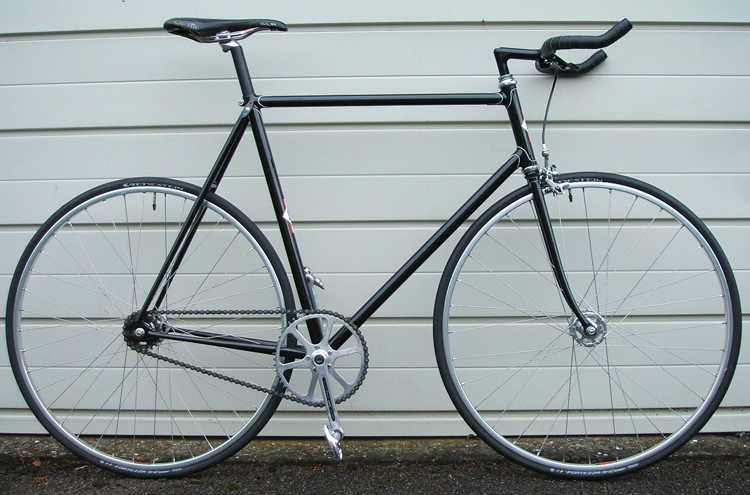
It is one of those bikes that make you go ‘wow’ when first ridden. The pedals are single-sided SPD. I shall take these pedals plus SPD shoes to Italy where I will rent a carbon Scott for the fortnight. Renting abroad can be a bit of a gamble re the quality of bikes on offer but we have previously used the bikes rented by our hotel and were very impressed with a machine that would have cost about £2000 in the UK. I take the SPD pedals rather than the more racy SPD SR version as we obviously do some sightseeing while away and I would feel very self-conscious hobbling round a church, gallery or somewhere similar on racy pedals. The SPD versions look just like a normal sport shoe as the cleats are recessed into the sole.
On the ride to Lode Patricia rode her ex-works team Diamond Back ‘Axis’ mountain bike which was a ‘works’ team bike for their women’s team and which has been hung up high in our garage for some 16 years since we moved to Cambridge. Before that Patricia toured extensively on it around the UK plus some trips to Bavaria to ride the Romantische Strasse and also for holidays in Garmisch-Partenkirchen with expeditions into the mountains around the twin towns. It was very very dusty when I took it down but came up like new when washed and polished. The one snag was in relation to the early-model Pace SC35 carbon suspension forks which had elastomer inserts that had completely bottomed out by some 40mm.
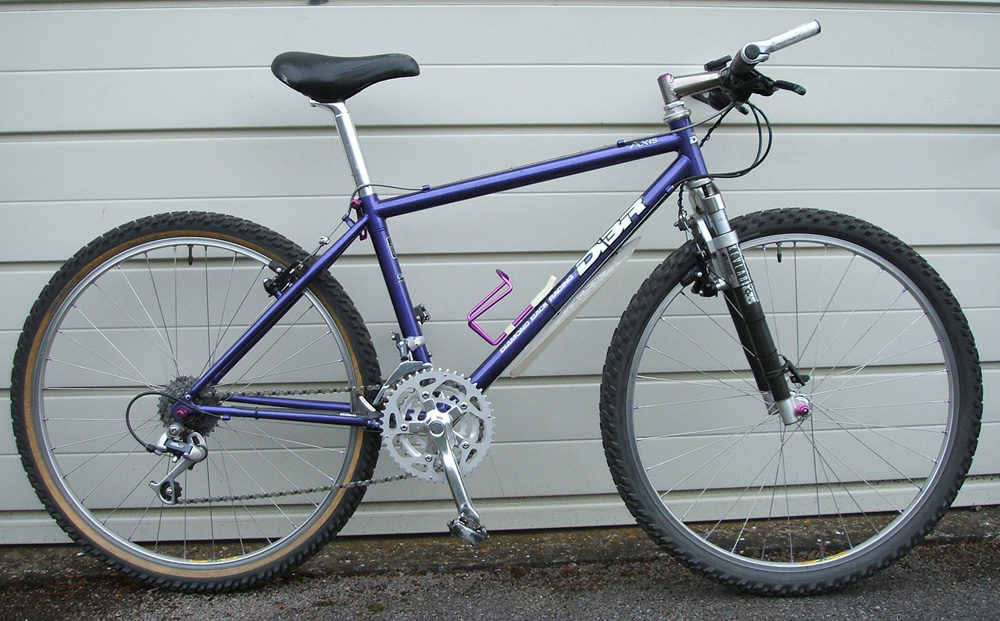
Knowing absolutely nothing about suspension forks, I took them to a local bike shop, Bicycle Ambulance, where Andy told me that these inserts just disintegrated over time – I found that hard to believe but, when he dropped the fork legs, all that was left of the 52mm polymers was about a teaspoon of a waxy-like substance. I did some research and found that replacements were virtually non-existent as the forks were about 20-years old. By a rare stroke of luck however there was a set for sale on Ebay from a cycle shop in Norwich that had a spare pair they never expected to use. We managed to win them at a reasonable cost. It was an amazing coincidence that they came up for sale at just the time we needed them when the bike had been unused and unseen for all these years. The forks have been re-assembled with the new polymers and Patricia is enjoying giving the Diamond Back a few outings after all this time.
The Universal Spanner from the Golden Age of Cycling by Bryan Clarke
In the days before the Mafac tool kit, quick release mechanisms and Allen key fittings, cyclists needed a saddle bag tool for all occasions. With a limit to the number of different ‘Imperial’ size nuts used by manufacturers of British cycle products, an ingenious and sturdy double open-ended spanner was made to satisfy this need that could truly be called universal.
By increasing the thickness of the casting it was possible to incorporate two different sizes at each end. As most cyclists rode with Williams and BSA chain sets, barring those with Chater-Lea, the smallest square shaped opening was for the box-shaped chain ring bolts used by these manufacturers. The other three openings could be used for the following:
– Front and a rear wheel nuts
– Seatpin bolts
– Brooks saddle clips
– Cotter pins
– BSA head clips
– Lamp brackets
– Some brake pivot bolts
– Some handlebar stems
If you were lucky to own a pair of ‘Allez’ pedals they would work on these too.
What more could you want? Well perhaps a small adjustable spanner and a screwdriver. A selection of these spanners is shown here.
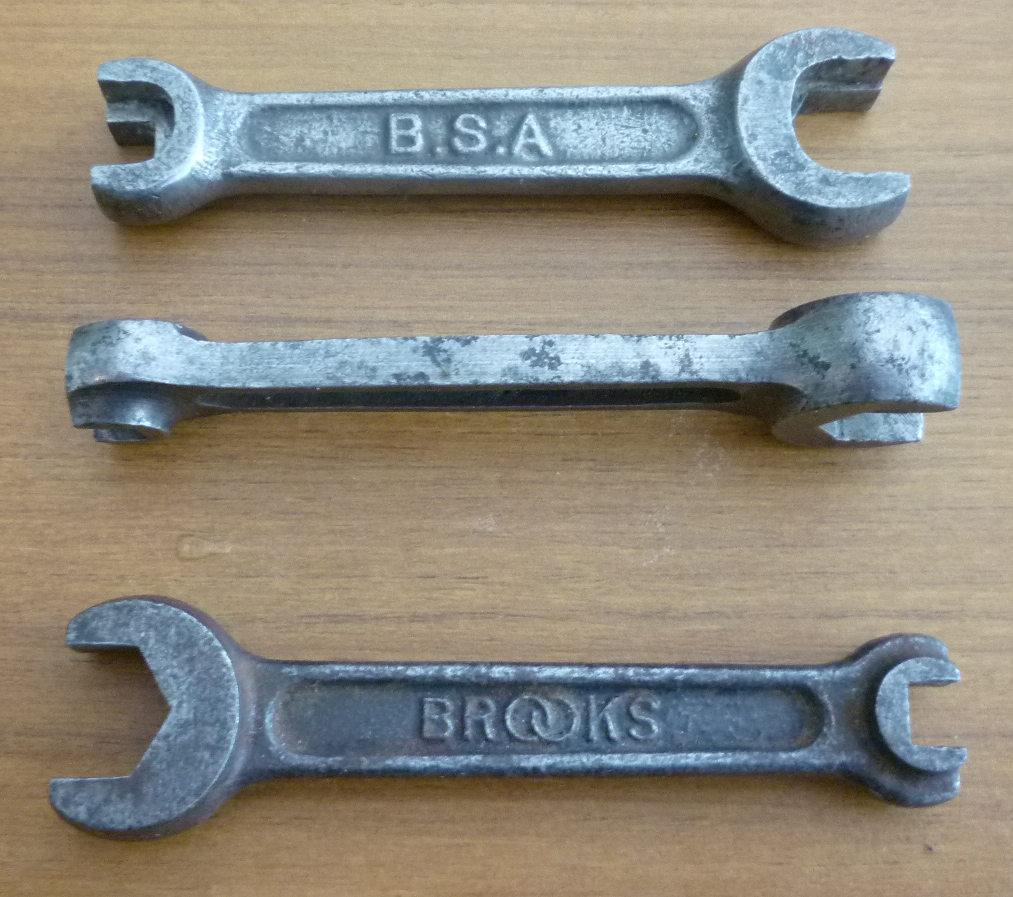
British Hub Company (BHC): Airlite, Solite & other Best of British Products. By Steve Griffith
For some, British Hub Co’s Airlite were the finest hubs ever produced, the acme of British quality which has never been equalled since. As this article will demonstrate, this Birmingham based company produced a wide range of hubs from the 1920’s until their demise at the end of the 1960’s. They also produced hubs for the motorcycle and car industries. BHC survived longer than their major rival Bayliss Wiley, but unlike the latter only made hubs and hub-related items e.g. sprockets, wingnuts and tools. As a cursory glance at the Holdsworthy Aids catalogues (1) reveals, the range of hubs declined from the late 40’s onwards until finally in 1969 there was a notice in Cycling that the stock and machinery were going to be sold at auction.
The company was founded in 1904 but only seem to have started making hubs in 1914 and then for the motor and motor cycle industry. During the 1920’s BHC primarily made hubs for the roadster and trade market. In the CTC Gazette show reviews (2) of the early 1930’s there are several references to BHC being pioneers of the internal expanding hub brake as applied to cycles (fig. 1). In 1935 they introduced their two hubs aimed at the lightweight market; the top of the range Airlite, steel barrel with alloy flanges, and the all steel Solite. BHC claimed the Airlite was the lightest hub in the world and some early versions even had alloy locknuts. These proved a liability in use and were quickly dropped. It was probably based on the Italian FB but slimmer to give the weight saving which was the key marketing focus . To many these hubs epitomise BHC but in fact they were only a very small percentage of their output. Slightly cheaper and all steel but still a quality product for lightweights was the Sivada hub
In the late 1930’s large flange hubs from Europe became fashionable; BHC answer was to rivet a larger flange on to a small flange hub to create the Airlite continental, which had already been done by on the French maker Prior.
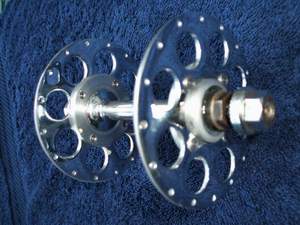
Often used on tandems, these hubs with the over sized flange are very sought after, although there can be problems with the rivets wearing after prolonged use. Only after WWII was a conventional large flange hub, the Airlite Continental produced. BHC was ahead of Bayliss Wiley who did not produce a large flange hub until 1945/6 (the distinctive version with only 4 and 5 lightening holes)
Airlite and Solite hubs were made in a variety of models; double fixed, gear fixed and gear sided. Also a model with extra wide flanges and drilling from 28 to 40 holes. When derailleurs became more popular they introduced a version that had the right chain line for use with multiple freewheels. The large flange Airlite and Racelite have ten lightening hole in the rear and eight in the front. Visually the hubs look very similar to Bayliss Wiley Continental & Powell (a Coventry maker of the 40’s early 50’s). Airlites tend to have slightly larger flanges and if you come across Airlites with larger flanges than others they are for tandems. Small flange front hubs with ¼ “ bearings and a wider axle & barrel (91mm compared to 82mm) are also for tandems (they also have a wider OLD of 106mm compared to 98mm). The barrels are stamped BHC Airlite but often due to chrome decaying this can be difficult to read. It should be pointed out the quality of the chrome is good, far better than Gnutti, FB, and Campagnolo. One other distinguishing feature is the Airlite has a tiny indent on the cone dust cover for grease injection.
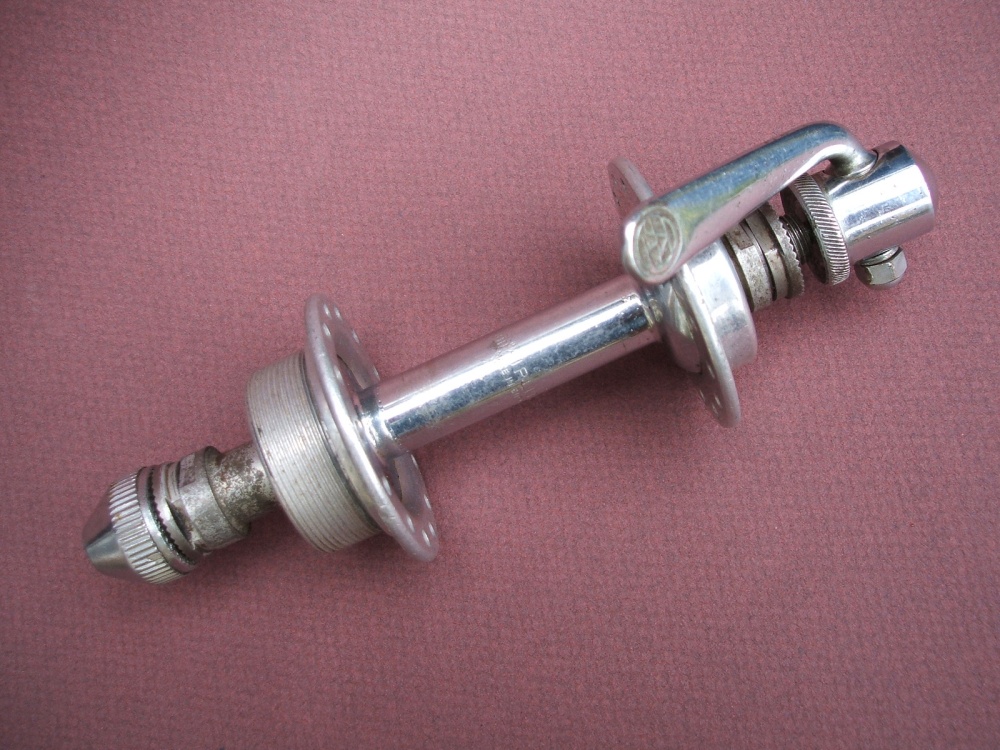
During World War Two BHC advertisements under the heading : The Best is Worth Waiting For stated that due to inability to source the right grade of metal, Airlites would not be made until the end of the war, but Solites and other were still being made, albeit in limited supplies. Customers are suggested to opt for the Solite Featherweight or Sivada Lightweight as an alternative.
After 1949 they offered anodised Airlite hubs & track nuts in gold, blue, black, green and red (an extra 3/9 in 1962). After prolonged exposure to sunlight they fade quite badly. There were only two products developed after the mid-50’s: the quick release version of the Airlite and Airlite continental hubs (fig. 3).
The skewer was a copy of the design created by Campagnolo (pre-WW2) but had a unique thread for the nut end. This was introduced in the autumn of 1953. The other product was the Racelite hub (fig. 4), introduced in 1957. This was their first all-alloy shell hub and visually identical to the French Normandy large flange hub which has been on the market since the early 1950’s. It was not the first British all-alloy hub shell – that distinction belongs to Harden and Blumfield who introduced their alloy hubs in 1946.
Both these products sadly illustrated the fact that by this time BHC was essentially copying non-British products; their days of innovation were over. From the mid 1950’s they struggled to compete with European products, especially FB, Campagnolo Record, and Grand Sport hubs which were seen as a more desirable and better quality. French hubs, mainly of the Normandy, Atom, and Maillard family were often cheaper although not the same quality as the Racelite. In 1960 they advertised a pair of thin steel cone spanners especially for this hub (3). They did make one limited run product in the early 60’s: an all-alloy Airlite small flange especially for the then new Moulton.
Not being able to speak to anyone who actually worked for BHC, I am unable to work out what exactly they made themselves and what parts were bought in. The two wing nut designs looks exactly like those made by the local Utility Company. Similarly, did they make the alloy Airlites flanges themselves?
Usage
A pair of Airlite Continentals on 27” Conloy rims are one of those combinations that look just right for a 40’s /50’s lightweight. I say 27” because for some reason they look wrong on 26”s. One tip when using: a layer of clear grease on the barrel prevents the all too common rusting. On some gear sided hubs there is an extra long cone which enables adjustment without having to take the freewheel off, a very useful feature. The Cylbrakes are extremely effective and ideal for a pre-war touring mount, but check brake linings. This is an ideal solution to the most difficult component to source for a machine of this period. Conloy, Lam etc brakes are out of reach of most pockets, Resilion are far too fiddly and may other cheaper steel brakes are simply ineffective.
I have always regarded the hubs as extremely hard wearing and it is extremely unlikely you would wear out a pair of cones. Talking to a major collector recently, he commented how on many of the Airlites he has seen (well over 100 pairs) the cones are often very well worn whereas on a comparable number of Campagnolo hubs this is not the case. I wondered whether it was the case that the latter being expensive was only kept for best use. There may have been an element of that but not only were Campagnolo better quality but they were far better sealed.
I think there were a number of reasons for their decline in the 1960’s: firstly their hubs were seen as old fashioned as opposed to the newer European products. Some riders have complained to me that the hubs were not that good at providing the right chainline for use with five and ten speed sets which were becoming the norm. Finally price. The Racelite was more expensive than the comparable French Le Tour and the Airlites were only 10% to 15% cheaper than Campagnolo Record and more expensive than the Campagnolo Tipo and Grand Sport Hubs (4)
HUB RANGE
| Model name | Date | Type | Comments |
| Airlite small flange | 1935–mid 60s | Steel barrel and alloy flange all drillings from 28 to 40 | Top of the range also in quick release version |
| Airlite large flange | 1937- mid 60’s | The classic continental hub | Pre-war riveted on flanges, also quick release version late 50’s |
| Solite | 1934-mid 60’s | All steel numerous versions Both solo and tandem versions; later had ¼” bearings in the front hub. | Distinctive brass oiler in centre of barrel. Finally only made in tandem version |
| Sivada | 1932- 1950 | Steel cheaper version of the Solite | Versions for fixed and the newer multispeed freewheels |
| Fivada | 1932- 1939 | Similar to Sivada but slightly cheaper | |
| Maxim | 1920’s to1950’s | Fat barrel ,tubular construction for carriers/ roadsters | Known after WW2 as carrier hubs |
| Eureka | 1920’s to1939 | Tubular construction but thinner diameter barrel than Maxim | |
| Defiance | 1933- mid 1960’s | All Steel described as made at a popular price, i.e. their cheapest hub | Half the price of the Solite, feature in the 1967 Holdsworthy Aids |
| Racelite | 1957-mid 60’s | All alloy, large flange only | Visually similar to French hubs eg Normandy |
| Cyklbrake | Mid 1920’s- late 50’s | Hub brake both tandem and solo versions | Originator of this type of brake for cycles first version in the 20’s made for rod brake systems |
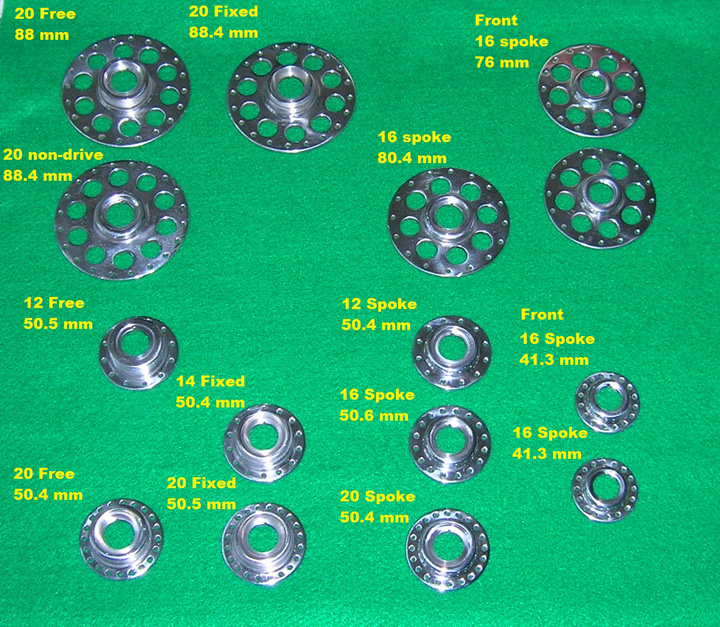
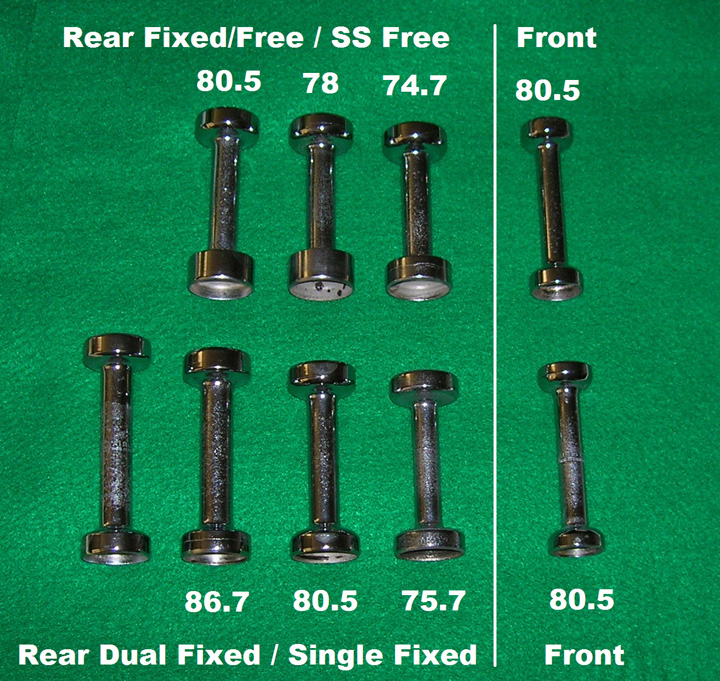
Appendix
Abbreviation used by BHC:
DS double fixed hub
WF wide flange for single sided track (fixed) hub
OS gear thread for boss type freewheels eg Simplex and Osgear
GI for standard multiple freewheel blocks
Company addresses in Birmingham
Weaman Street until c1955 then 123 Northwood Street
References
Ref 1 1969/70 Holdsworthy Aids is the last catalogue to feature their products
Ref 2 see CTC Gazette show reviews December 1930, December 1932
Ref 3 CTC Gazette for most months in 1960 ,March onwards
Ref 4 Holdsworthy Bike Rider Aids 1969/70 pp63 to 65
Other sources
BHC catalogues in the VCC online library there is: 1937, another undated pre war two, early and late 50’s
Brown Bros catalogues have a very comprehensive range of hubs illustrated
www.classiclightweights.co.uk has a very useful page of technical data on Airlites, e.g. flange & barrel diameters
My thanks to John Macgregor and Alexander von Tutschek for their help
Ref 1 1969/70 Holdsworthy Aids is the last catalogue to feature their products
Ref 2 see CTC Gazette show reviews December 1930, December 1932
Ref 3 CTC Gazette for most months in 1960 ,March onwards
Ref 4 Holdsworthy Bike Rider Aids 1969/70 pp63 to 65
Other sources
BHC catalogues in the VCC online library there is: 1937, another undated pre war two, early and late 50’s
Brown Bros catalogues have a very comprehensive range of hubs illustrated
www.classiclightweights.co.uk has a very useful page of technical data on Airlites, e.g. flange & barrel diameters
My thanks to John Macgregor and Alexander von Tutschek for their help
For sale: Macleans 1952 Eclipse KB 905 Original paint and transfers. 23″ CTT, Top tube 22 1/2″CTC, WB 41 1/2″, angles 74degs/72degs. Weight under 6lbs with Brampton Alatet headset. BB
height 11″ on 27s, Standover 32 3/4″ on 27s, drop-out width 95mm front,
115mm rear. No braze-ons for gears. Comes with original Guarantee.
Bryan adds that he has a further batch of Youngs and Grandini transfers printed.
Ephgrave wanted
My name is Rob Ephgrave. I am the grandson of Norm Ephgrave. For some time now I have been looking for a complete original Ephgrave lightweight with No. 1 lugs. I have a No.2 lug frame already.
Doug Empson (King’s Lynn area)
I have a nice YOUNGS of LEWISHAM, but it`s too big for me, it`s 22½” to the top of seat lug and 23″ top tube. Good condition and would look nice with a re-spray. It has round forks, Campag long ends and wrapover top eyes. I would think it is from Wally Greens workshop and it has NERVEX lugs. Does anybody have a Track or Road- Path model 21″ as I would like to get a Fixed wheel bike on the road.
dougempson@aol.com
I am looking for a Hines of Finchley Racing Bicycle. I am on a mission to find one of these frames for Luke Hines, grandson of Mark Hines, who made these frames in Finchley up until about 1964.
Luke’s father Martin Hines, son of Mark Hines, passed away in Sept 2011. He was desperate to get hold of a Hines Racing bike to keep in the family. I am a member of the current kart race team, and am trying desperately to find a frame for Luke Hines, who is continuing his late father’s wish to get a cycle back into the family.
We are looking for any “Hines of Finchley” Frame from 1960’s onwards. The frames before 1959/1960 were known as Hines & Green (Wally Green). Wally Green left in late 1959 to work for the Samuelson film service.
After Wally left, Mark Hines continued making his own frames, and it is one of these we are after. The frames were built as “lightweight road racing bikes”. Sadly the family haven’t kept one frame. It was Martin’s wish, before he sadly passed away, to get a frame to display as a part of the Hines history at their base now in Silverstone. Wally Green frames seem to be out there – I have found several.
The idea is to find any “Hines of Finchley” frame from late 1959/early 1960’s. Luke, Martin’s son and Mark’s grandson is our friend and team boss but he has his work cut out running the businesses and team. I have assigned myself to this quest, hoping I can reunite a Hines frame with the family. Something, I know, must be done, if anything to fulfil Martin’s wish.
I personally have a wish to see a frame from my Uncle Frank, Frank C.E. Ely of Grantham in Lincolnshire. He had a bicycle, motorcycle and lawnmower shop in Grantham doing both sales and repairs from mid-50’s to the early 80’s where I used to help as a small child when I stayed with them on holidays. He used to put me on a Hines frame and pull the bike around even when my feet couldn’t touch the pedals. He used to tell me how the frame was fantastic and that he had won a few road races.
I think he had designs on me being a road racer, speedway racer, or something like that. His love of motorsport grew on me, which is why I am heavily engaged in that world. After my uncle emigrated to Spain and sadly passed away the bike was gone, lost in time. So it does have a special significance for me, also as my great uncle, who later became Lord Mayor of Grantham, was very dear to me, and I to him. He couldn’t have kids of his own. Just to be able to see a frame, would be quite emotional.
I have asked Luke Hines to try and find some info, frame numbers etc, but I think he is finding this impossible. Such a long time ago.
If you can be of any assistance, could please let me know,
Robert
Wills Racing Team, 44 School Lane, Swavesey, Cambridgeshire, CB24 4RL
Tel : 01954 232 947 or Mob : 07762 907 681
Email: willsracing@ntlworld.com
Posted: Sunday 14th July 2013
This article appears in the following categories.
Upcoming Events
Whether you are looking for a gentle social meet up, or a 100-mile ride browse the community’s upcoming events and plan your next weekend outing.
